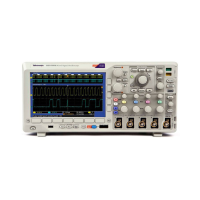Trigger Setup
Selecting Triggers
Trigge r Type Trigger Conditions
Edge
Trigger on a rising or falling edge, as defined by the
slope contro
l. Coupling choices are DC, AC, LF Reject,
HF Reject, and Noise Reject.
Edge triggers are the simplest and most commonly
used trigge
r type, with both analog and digital signals.
An edge trigger event occurs when the trigger source
passes through a s pecified voltage level in the specified
direction.
Sequence
(B Trigger)
Combine an
edge A Event (Main) trigger with the
B Event (Delayed) trigger to capture more complex
signals. (See page 81, Using Sequence Trigger, A
(Main) and
B (Delayed).)
Time. After the A Event occurs, the trigger system waits
the specified amount of time, and then looks for the B
Event bef
ore triggering and displaying the waveform.
Events.
After the A Event occurs, the trigger system
looks for a specified number of B Events before
triggering and displaying the waveform.
Pulse Wi
dth
Trigger
on pulses that are less than, greater than, equal
to, not equal to, a specified time. Additionally, you can
trigger when a pulse width is w ithin or outside a range
of two d
ifferent specified times. You can also trigger on
positive or negative pulses. Pulse width triggers are
primarily used on digital s ignals.
Timeout
Trigger when no pulse is detected within a speci fi ed
time.
Runt Trig
ger on a pulse amplitude that crosses one threshold
but fails to cross a second threshold before recrossing
the first. You can detect positive or negative (or either)
run
ts, or only those wider than, less than, greater than,
equal to, or not equal to a specified width. Runt triggers
are primarily used on digital signals.
74 MSO3000 and DP O3000 Series Oscilloscopes User Manual

